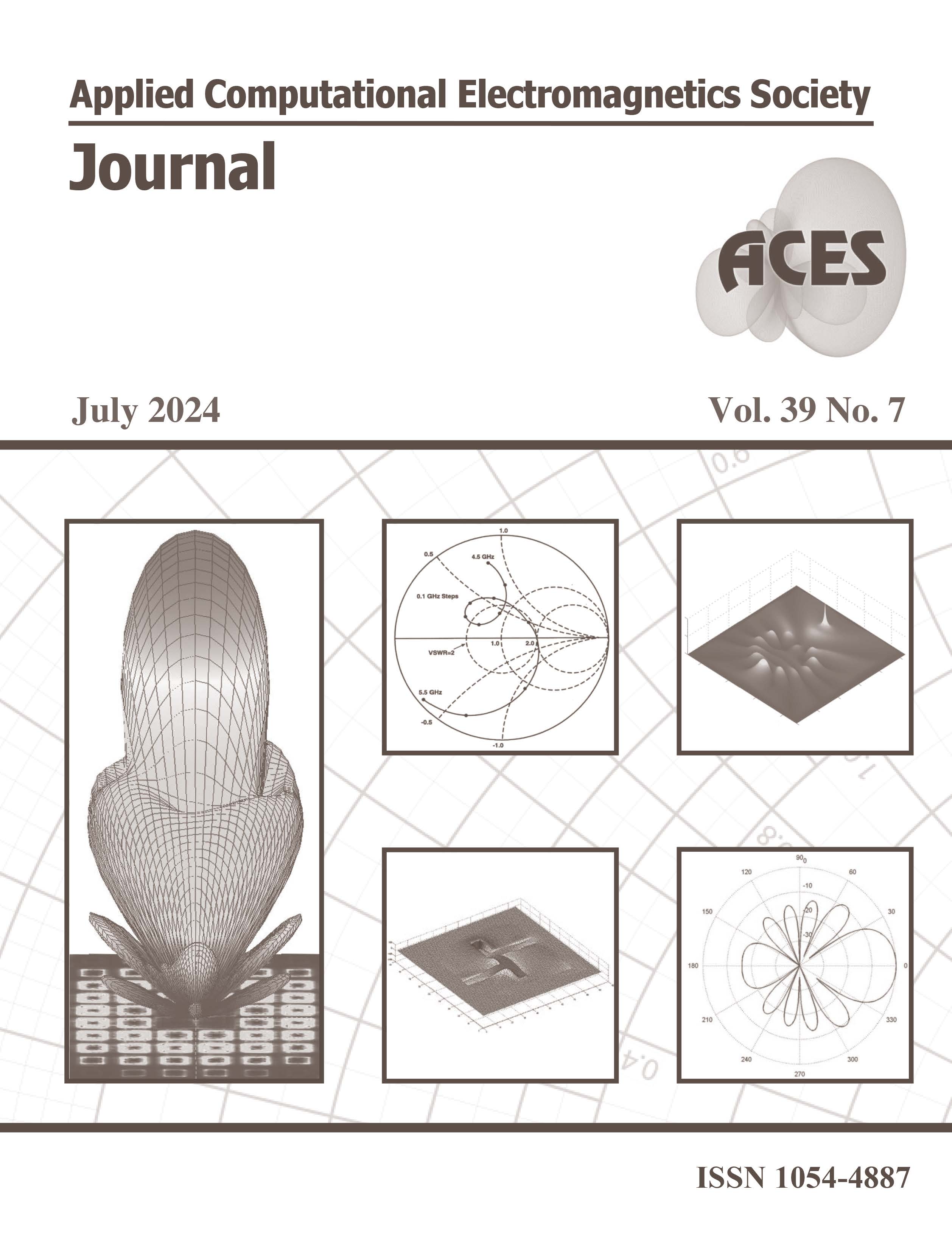Analysis and Simulations of Electrothermal Characteristics of Water-based Ultrawideband Absorber Using HIE-FVM Hybrid Method
DOI:
https://doi.org/10.13052/2024.ACES.J.390704Keywords:
Electrothermal coupling computation, FVM, HIE-FDTD, Water-based absorberAbstract
In this study, the dispersion characteristics, impedance features, and absorption conditions of water-based electromagnetic (EM) absorbers are investigated. A methodology for the rapid construction of a three-layer water-based absorber structure is proposed. Concurrently, a weakly conditionally stable Hybrid Implicit-Explicit Finite Difference Time Domain (HIE-FDTD) method is introduced to enhance the computational efficiency of thin layer structures. Furthermore, the EM computation integrates thermal effect calculations. A hybrid approach, combining the HIE-FDTD and Finite Volume Method (FVM), is employed to analyze temperature variations induced by EM wave incidence on the absorber.
Downloads
References
Y. Zhang, H. Dong, N. Mou, H. Li, X. Yao, and L. Zhang, “Tunable and transparent broadband metamaterial absorber with water-based substrate for optical window applications,” Nanoscale, vol. 13, no. 16, pp. 7831–7837, 2021.
H. Xiong and F. Yang, “Ultra-broadband and tunable saline water-based absorber in microwave regime,” Optics Express, vol. 28, no. 4, pp. 5306–5316, 2020.
Z. Wu, X. Chen, Z. Zhang, L. Heng, S. Wang, and Y. Zou, “Design and optimization of a flexible water-based microwave absorbing metamaterial,” Applied Physics Express, vol. 12, no. 5, p. 057003, 2019.
W. Zhu, I. D. Rukhlenko, F. Xiao, C. He, J. Geng, X. Liang, M. Premaratne, and R. Jin, “Multiband coherent perfect absorption in a water-based metasurface,” Optics Express, vol. 25, no. 14, pp. 15737–15745, 2017.
A. Taflove and S. C. Hagness, Computational Electrodynamics: The Finite-Difference Time-Domain Method, 3rd ed. London: Artech House, 2005.
A. Z. Elsherbeni and V. Demir, The Finite-Difference Time-Domain Method for Electromagnetics with MATLAB Simulations, 2nd ed. Raleigh, NC, 2015.
N. J. Ryan, B. Chambers, and D. Stone, “FDTD modeling of heatsink RF characteristics for EMC mitigation,” IEEE Transactions on Electromagnetic Compatibility, vol. 44, no. 3, pp. 458–465, 2002.
M. A. Alsunaidi and A. A. Al-Jabr, “A general ADE-FDTD algorithm for the simulation of dispersive structures,” IEEE Photonics Technology Letters, vol. 21, no. 12, pp. 817–819, 2009.
J. Chen and J. Wang, “A three-dimensional semi-implicit FDTD scheme for calculation of shielding effectiveness of enclosure with thin slots,” IEEE Transactions on Electromagnetic Compatibility, vol. 49, no. 2, pp. 354–360, 2007.
J. Wang, B. Zhou, L. Shi, C. Gao, and B. Chen, “A novel 3-D HIE-FDTD method with one-step leapfrog scheme,” IEEE Transactions on Microwave Theory and Techniques, vol. 62, no. 6, pp. 1275–1283, 2014.
K. Niu, Z. Huang, X. Ren, M. Li, B. Wu, and X. Wu, “An optimized 3-D HIE-FDTD method with reduced numerical dispersion,” IEEE Transactions on Antennas and Propagation, vol. 66, pp. 6435–6440, Nov. 2018.
W. Yan, Q. Cao, and Y. Wang, “Analysis of electromagnetic/thermal coupling of debye media using HIE-FDTD method,” Journal of Electromagnetic Waves and Applications, vol. 37, no. 10-12, pp. 939–949, 2023.
S. Wunsche, C. Clauß, P. Schwarz, and F. Winkler, “Electro-thermal circuit simulation using simulator coupling,” IEEE Transactions on Very Large Scale Integration (VLSI) Systems, vol. 5, no. 3, pp. 277–282, 1997.
S. Watanabe, M. Karakawa, and O. Hashimoto, “Computer simulation of temperature distribution of frozen material heated in a microwave oven,” IEEE Transactions on Microwave Theory and Techniques, vol. 58, no. 5, pp. 1196–1204,2010.
F. Torres and B. Jecko, “Complete FDTD analysis of microwave heating processes in frequency-dependent and temperature-dependent media,” IEEE Transactions on Microwave Theory and Techniques, vol. 45, no. 1, pp. 108–117, 1997.
K.-M. Huang and Y.-H. Liao, “Transient power loss density of electromagnetic pulse in debye media,” IEEE Transactions on Microwave Theory and Techniques, vol. 63, no. 1, pp. 135–140,2014.




